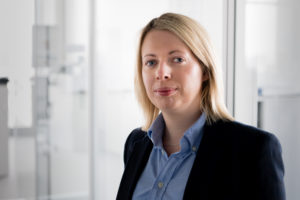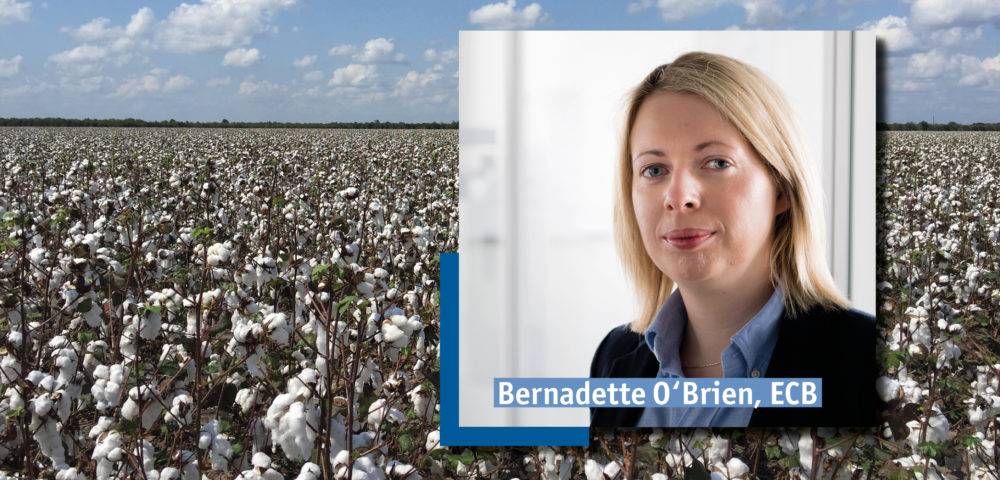Interview with Bernadette O’Brien from the Banknote Directorate, European Central Bank:

In addition to price stability and safeguarding the European banking system, the sustainable production of euro banknotes is high on the agenda at the European Central Bank (ECB) in Frankfurt. The editors of the Bremen Cotton Report spoke with Bernadette O‘Brien from the Banknote Directorate at the ECB about the production process and associated challenges.
CR: Mrs O‘Brien, who‘s the ECB?
The European Central Bank (ECB) is the central bank of the 19 European Union countries which have the euro as their common currency. Its main task is to maintain price stability and ensure the safety and soundness of the European banking system. Developing and issuing euro banknotes is also one of the ECB’s responsibilities, which falls under the Directorate banknotes. Since 2002, when the first euro banknotes were issued, the ECB coordinates the production and the issuance of euro banknotes for the countries that use the euro as their currency. The ECB ensures that high health, safety and environmental standards are maintained during the production of euro banknotes and their main raw materials.
Which role does cotton have in the euro banknotes production process?
Euro banknotes are printed on pure cotton-fibre paper, which gives them their special crispness and wear resistance. Since 2014, the ECB gradually introduced the use of cotton from sustainable sources into the production of euro banknotes, which are more environmentally friendly than traditional sources and contribute to reducing the environmental impact of banknotes’ production.
The production of euro banknotes is a complex decentralised task coordinated by the ECB. Several high-security printing works in Europe produce the banknotes that are subsequently distributed across the euro area. The paper mills taking care of producing the banknote paper are responsible for sourcing the cotton.
Can you explain the banknote production process?
Euro banknote production starts with the paper making where the cotton-based paper is produced, which includes a watermark, embedded security thread and applied metallic foil. The paper is then cut into sheets and transported to the printing works, where the printing process starts.
The offset printing, which consists of simultaneously printing a multi-coloured background on both sides of the paper, is the first phase of the printing process. This is followed by the silkscreen printing, which is when the emerald number, a shiny number, is applied to on the front of the banknotes. Intaglio printing is the third phase of the process, in which ink is applied under high pressure. Finally, the serial number is applied at the numbering press. Some of the banknote denominations (€5, €10, and €20) go through a fifth printing step, in which they are coated with a varnish layer to make them more resistant and extend their life. After the printing process, the paper sheets are cut into banknotes.
Does the approach in using cotton also exist in other non-European countries or what do they use? Why do we use cotton here?
For centuries, various materials have been used to make money, including leather, precious metals, shells, cotton paper and most recently, plastic. In 1998, Australia introduced polymer banknotes, which are now used in over 30 countries. According to a recent report*, 90% or more of the world’s banknotes are still made out of plant-based paper.
Cotton is used for euro banknote paper as it is stronger than paper based on other natural fibres and makes banknotes durable and resistant. Moreover, cotton allows for high quality printability, and allows for high performing security features to be embedded.
What challenges does the ECB face in sourcing cotton?
The cotton used in euro banknotes is primarily cotton noils. Sourcing of such certified sustainable cotton was challenging in the beginning and we continue to monitor the availability of the evolving sustainable cotton programmes.
In addition, some paper mills use cotton linters in the paper production, whose certified sustainability is not available. This is why several paper mills discarded the use of linters, turning to alternative solutions to ensure the sustainability of the cotton used for the euro banknotes. In the meantime, the ECB, in close cooperation with the paper mills, is currently investigating the sourcing of sustainable linters going forward.
What approaches are you pursuing to make banknotes more sustainable?
The ECB is continually improving the environmental sustainability of euro banknotes. We began this journey back in 2004 when the first Life Cycle Assessment (LCA) was conducted on euro banknotes. The sustainable cotton programme was a key outcome of this study due to the impact of cotton, coming from its cultivation.
Initiatives on waste management have also evolved over the years as recycling solutions are being explored. The ECB is currently conducting a new environmental impact assessment using the Product Environmental Footprint (PEF) method launched by the European Commission that will allow us to identify opportunities to further reduce the environmental impact of euro banknotes.
What is the ECB‘s definition of sustainability, do you follow guidelines, or do you have your own policies?
In terms of sustainable cotton, this is cotton from certified labels or programme such as organic, fair-trade cotton and integrated cotton productions.
How do you assess the future development of banknotes against the background of increasing paperless payment transactions?
Cash is an important part of our freedom to choose how to pay and essential for the financial inclusion of all groups in society. Our cash strategy aims to ensure that cash remains widely available and accepted as both a means of payment and a store of value.
Thank you very much for the interview!
*https://www.coinworld.com/news/paper-money/paper-or-plastic-for-world-s-bank-notes
More informationen about the ECB:
The interviews in the column “Question Time“ embody the opinion of the respective interview partner and do not represent the position of the Bremen Cotton Exchange as neutral, independent institution.


